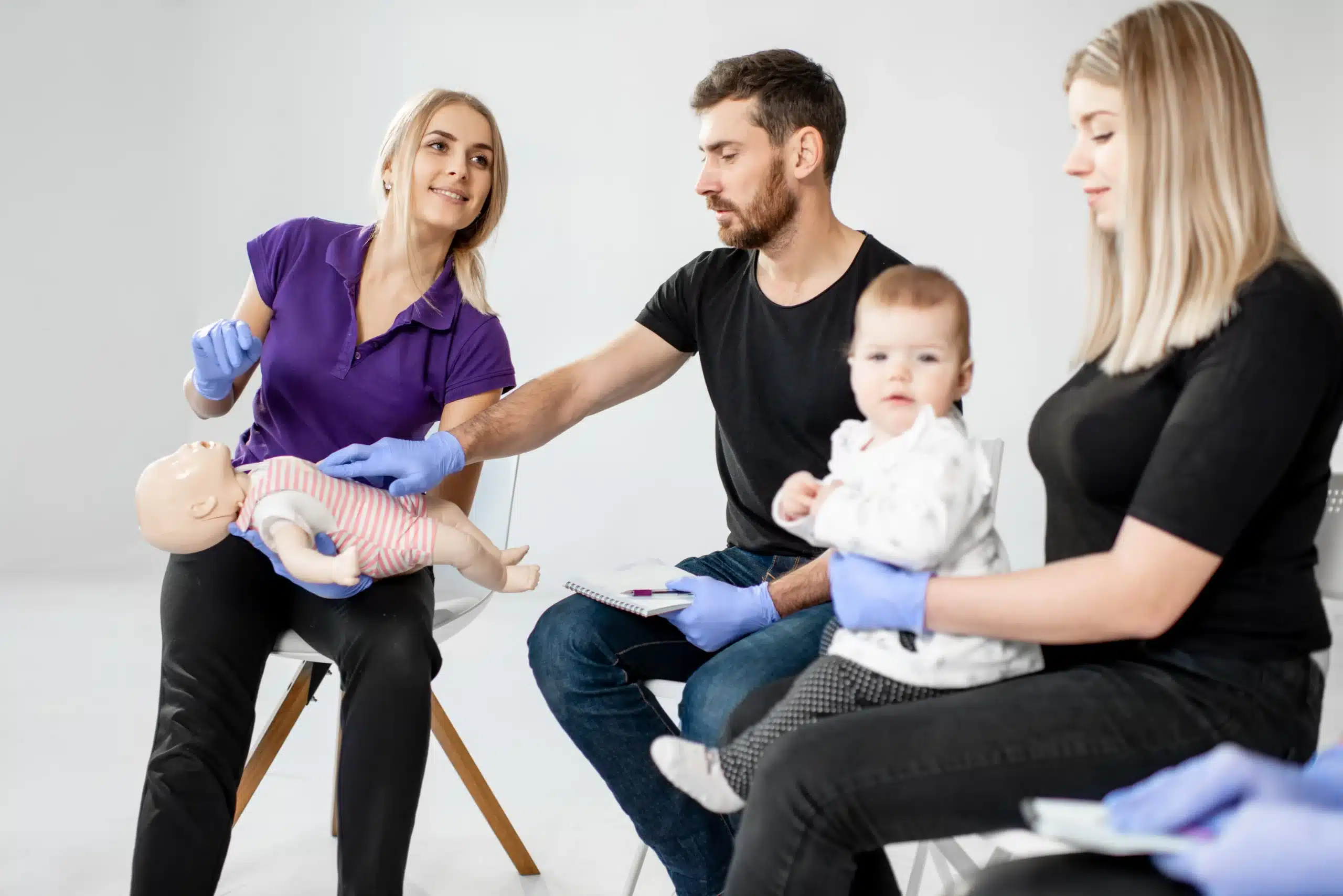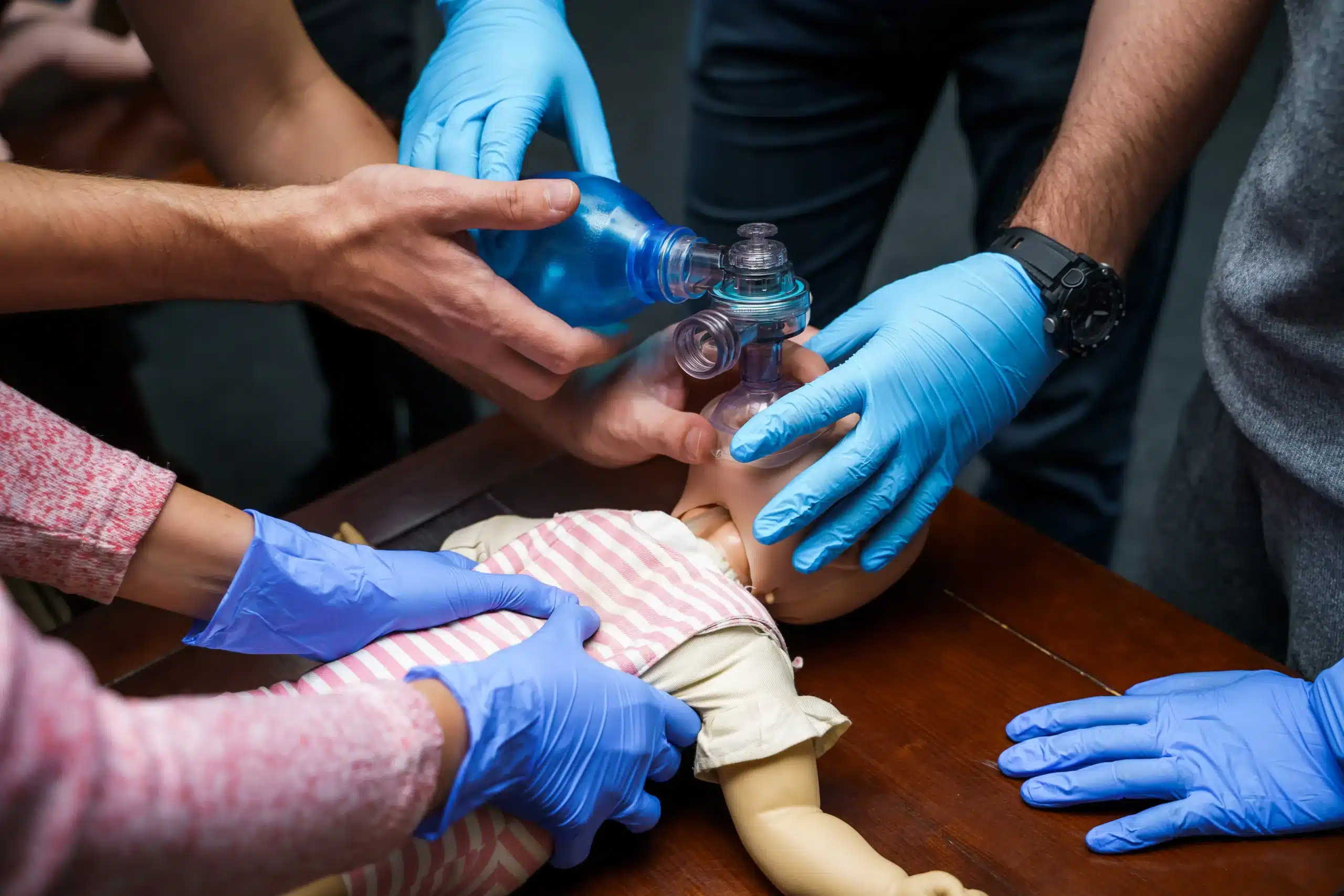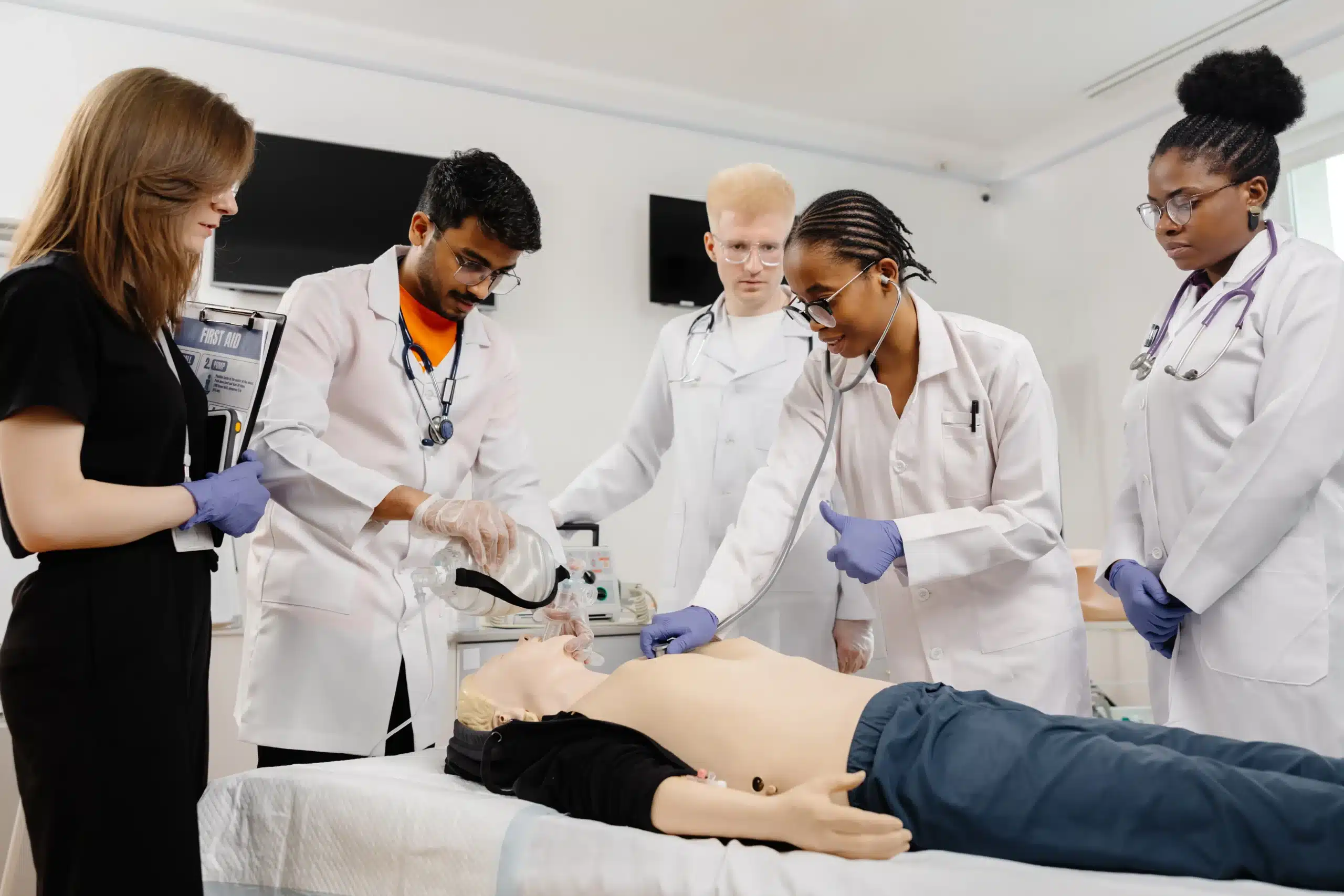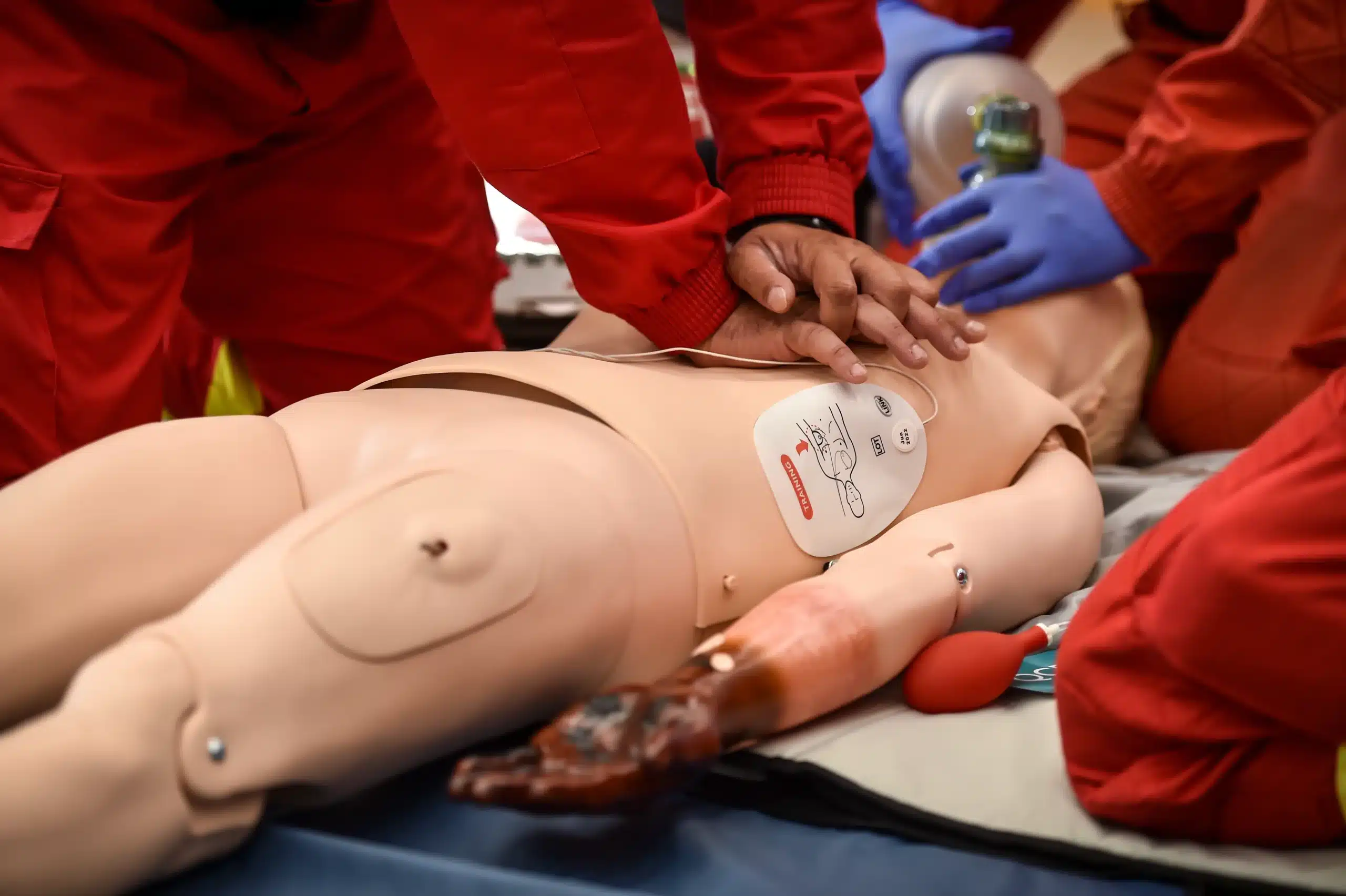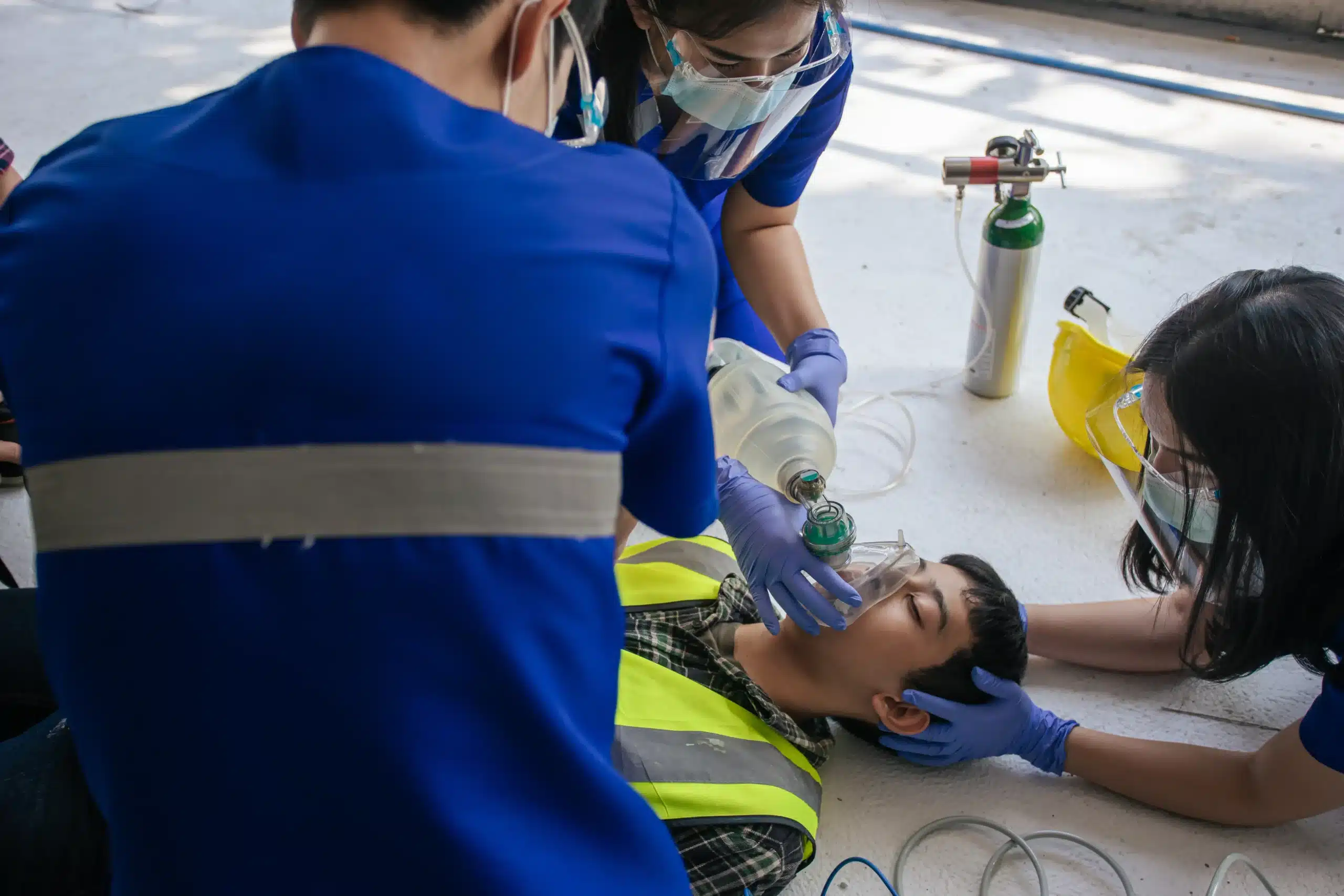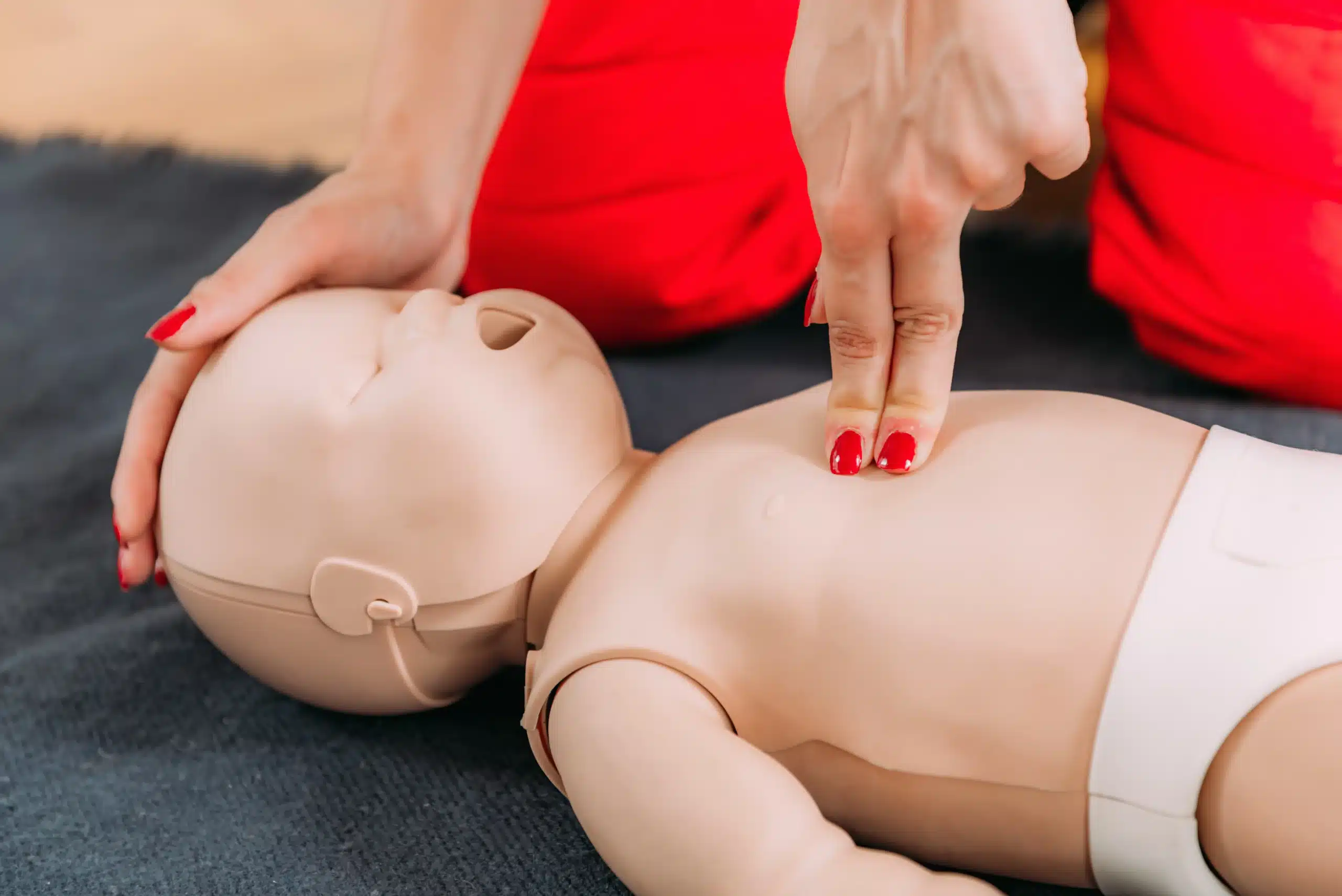Equipping your San Francisco team with life-saving skills is an investment in their well-being and your company’s future. Workplace CPR certification in San Francisco provides employees with the knowledge and confidence to handle medical emergencies effectively. But where do you start? This article simplifies the process, guiding you through the different CPR certification options, leading providers in San Francisco, and the steps to implement a successful workplace CPR program. We’ll also explore the broader benefits of a CPR-trained workforce, from enhanced safety and reduced liability to improved employee morale.
Key Takeaways
- CPR-trained employees are essential for a safe workplace: From basic CPR to advanced certifications like ACLS and PALS, providing appropriate training empowers your team to handle emergencies effectively and builds a culture of preparedness.
- Find the right CPR training partner: Look for AHA-aligned courses, experienced instructors, and convenient options like on-site training and flexible scheduling to meet your company’s specific needs and budget.
- Cultivate a safety-conscious environment: Regular practice, well-defined emergency plans, and ongoing education are crucial for maintaining skills and ensuring your team can respond confidently in any situation.
What is Workplace CPR Certification in San Francisco?
Workplace CPR certification in San Francisco equips your employees with the skills to handle medical emergencies, especially cardiac arrest. These certifications are essential for workplace safety, ensuring your team can respond effectively if a crisis arises. CPR-certified employees can provide immediate assistance while waiting for professional medical help to arrive, potentially saving lives.
Several organizations offer CPR and First Aid training in San Francisco, with certifications typically valid for two years. Renewal courses are readily available to keep your team’s skills sharp. Some providers, like Heart Start CPR, offer convenient on-site training tailored for businesses. Safety Training Seminars is another excellent resource, offering a range of American Heart Association courses, including CPR, BLS, ACLS, and PALS, in San Francisco. They prioritize accessibility, offering daily classes and a low-price guarantee. Having trained personnel readily available can truly make a difference in a critical situation.
CPR Courses for San Francisco Workplaces
Knowing which CPR course suits your workplace best depends on your industry and employees’ roles. Here’s a breakdown of common CPR courses available in San Francisco:
Basic CPR and First Aid
This course is an excellent starting point for anyone. It covers essential life-saving skills, including CPR for adults, children, and infants, AED use, and basic first aid for common injuries like burns and cuts. The American Red Cross offers reliable certification courses throughout San Francisco and California. Remember that certifications typically expire after two years, so factor in renewals when planning your training.
Basic Life Support (BLS)
BLS certification goes further than basic CPR and is often a requirement for healthcare providers and other medical professionals. It covers more in-depth techniques for single-rescuer and team-based CPR, advanced airway management, and other critical skills. Heart Start CPR offers convenient on-site BLS training in the San Francisco Bay Area for businesses to train their teams. They also provide certifications like ACLS and PALS.
Advanced Cardiovascular Life Support (ACLS)
ACLS courses are designed for healthcare professionals responding to cardiovascular emergencies. This training covers advanced life support techniques, including ECG interpretation, pharmacology, and team dynamics during resuscitation. Safety Training Seminars is a popular provider in San Francisco, offering ACLS courses alongside other AHA certifications like BLS and PALS, known for competitive pricing and convenient daily classes.
Pediatric Advanced Life Support (PALS)
Designed for healthcare providers treating infants and children, PALS certification focuses on the specialized skills needed to respond to pediatric emergencies. Like ACLS, it covers advanced life support techniques tailored to younger patients. Heart Start CPR offers PALS training alongside other CPR and first aid courses, providing a comprehensive solution for businesses with diverse training needs.
Neonatal Resuscitation Program (NRP)
The NRP course is essential for healthcare professionals involved in newborn care. It covers resuscitation techniques specific to neonates, focusing on the immediate care required after birth. Safety Training Seminars offers NRP courses, including the RQI (Resuscitation Quality Improvement) program, which combines online learning with hands-on skills testing—a convenient option for busy professionals.
Top CPR Certification Providers in San Francisco
Finding the right CPR certification provider is crucial for both individuals and businesses. Here’s a rundown of some reputable options in San Francisco:
Safety Training Seminars
Safety Training Seminars offers American Heart Association (AHA) certified courses, including CPR, BLS, ACLS, and PALS, right here in San Francisco. With a focus on affordability and convenient daily classes, they also provide the RQI program for healthcare professionals. Their commitment to low prices makes them a budget-friendly choice.
American Red Cross
The American Red Cross is a well-known provider of CPR and first aid certification courses in San Francisco. Their certification is widely accepted, and they offer renewal courses to help you stay current.
Heart Start CPR
If you’re looking for on-site training for your business or organization, Heart Start CPR brings the training to you. They serve the San Francisco Bay Area, and their instructors are experienced firefighters, paramedics, nurses, and EMTs, offering real-world expertise.
San Francisco Fire Department
The San Francisco Fire Department provides CPR training and certification as part of their community outreach. Check their website for information on upcoming courses and programs. This can be a great option for individuals seeking a community-focused approach.
CPR Training Solutions
CPR Training Solutions offers various CPR and first aid courses tailored to individuals and organizations in San Francisco. They focus on ensuring compliance with OSHA and other regulatory standards, making them a good choice for businesses.
Bay Area CPR
Bay Area CPR offers a range of CPR and first aid classes, including BLS and ACLS. They emphasize hands-on training and real-world scenarios to prepare you for actual emergencies. Learn more about their course offerings.
ProCPR
For those with busy schedules, ProCPR offers the convenience of online CPR certification courses. This allows you to learn at your own pace while still acquiring essential lifesaving skills.
CPR Certification Course Costs & Value
CPR certification classes in San Francisco vary in price depending on a few factors. The type of class (adult-only, child/infant, or all-inclusive CPR training), the format (online, in-person, or hybrid), and the certification level all play a role. Understanding these variables helps you choose a course that meets your needs and budget. For more on CPR class costs, take a look at this helpful resource on CPR class costs in Oakland. CPR Class Costs in Oakland
Individual Course Pricing
Individual course pricing usually reflects the training’s depth and length. Basic CPR classes are generally more affordable than advanced certifications like ACLS or PALS. In-person classes, offering hands-on practice with certified instructors, may be slightly more expensive than online or hybrid courses. Compare pricing from different providers to find the best value. Safety Training Seminars offers a low-price guarantee, so you receive high-quality training at a competitive price. Low Price Guarantee
Group Rates and Discounts
Many CPR training providers offer discounts for group bookings, making it a smart choice for businesses, schools, or community groups. This can lower the per-person cost, especially for larger groups. Companies like Heart Start CPR specialize in on-site training, bringing the instruction to your workplace. Their tiered pricing offers increasing discounts as the group size increases. Onsite CPR Training For San Francisco businesses, Safety Training Seminars offers group discounts on BLS, ACLS, and PALS courses. BLS, ACLS, and PALS Courses
Return on Investment for Businesses
While there’s an upfront cost for CPR training, the potential return on investment for businesses is significant. Equipping your employees with these skills creates a safer work environment and reduces liability risks in emergencies. CPR-trained employees project preparedness and professionalism, boosting confidence among staff and clients. Articles like “The Impact of CPR Training in the Workplace” and “CPR: 7 Critical Reasons for Training at Work” highlight the many benefits, from better emergency response to improved employee morale. Impact of CPR Training 7 Reasons for CPR Training at Work A CPR-trained workforce shows a commitment to safety and well-being, invaluable for a positive company culture.
CPR Certification Requirements & Renewal
CPR certification is essential for anyone working in healthcare or other fields requiring these life-saving skills. This section clarifies the steps to get initially certified, how to renew your certification, and best practices for maintaining your skills.
Initial Certification Steps
Getting your initial CPR certification is straightforward. Several organizations offer training courses in San Francisco. The American Red Cross provides comprehensive CPR and First Aid classes throughout California. For convenient on-site training tailored to businesses, consider Heart Start CPR. Safety Training Seminars offers a range of American Heart Association (AHA) courses, including CPR, BLS, ACLS, and PALS, catering to various professional needs. These courses cover essential techniques and provide the knowledge and skills to respond effectively in emergencies.
Renewal Timeline and Requirements
CPR certifications typically expire after two years. To maintain your certification, take a renewal course. The Red Cross and Safety Training Seminars offer renewal courses to refresh your knowledge and skills. Staying current ensures you’re always prepared to provide assistance when needed. Check with your certifying organization for specific renewal requirements.
Maintaining Certification Standards
CPR techniques and best practices evolve, so staying up-to-date is crucial. Hands-on training, like that offered by the Red Cross, is the most effective way to learn and retain these skills. Reputable courses emphasize practical application, often using mannequins and realistic scenarios. This approach provides a more engaging and effective learning experience than online-only options, as highlighted by Emergency First Response. Regular practice and continuing education will help maintain proficiency and confidence in your CPR abilities.
Benefits of CPR-Certified Employees
Having CPR-certified employees offers several advantages, creating a safer and more prepared work environment. From minimizing risk and meeting legal requirements to boosting employee morale and potentially saving lives, the benefits are significant.
Enhanced Workplace Safety
A workplace with CPR-trained staff is inherently safer. CPR certification equips your team to respond effectively during medical emergencies like cardiac arrest. This immediate action can significantly improve survival rates by minimizing the wait time for professional medical assistance. Every second counts in these critical situations, and having trained responders on-site can make all the difference. Learn more about how CPR training creates a safer workplace.
Legal Compliance and Liability Reduction
Many industries have regulations regarding workplace safety and first aid preparedness. Providing CPR training helps your company meet these legal requirements and demonstrates a commitment to employee well-being. Furthermore, it can reduce your company’s liability in the event of a medical emergency. By showing that you’ve taken reasonable steps to prevent harm through CPR training, you strengthen your legal standing.
Improved Employee Confidence and Morale
CPR training empowers employees with valuable life-saving skills, leading to increased confidence and a greater sense of responsibility. Knowing they can assist in a crisis boosts morale and fosters a culture of preparedness and mutual support within the team. This positive impact extends beyond emergency situations, contributing to a more engaged and positive work environment. Explore the positive impact of CPR training on workplace culture.
Potential for Life-Saving Outcomes
Ultimately, the most significant benefit of having CPR-certified employees is the potential to save lives. While we hope such skills are never needed, being prepared for medical emergencies can dramatically improve outcomes. CPR-trained staff can provide immediate assistance during cardiac arrest, strokes, or choking incidents, significantly increasing the chances of survival and minimizing long-term health consequences. Understand the value of workplace CPR training and its potential to make a life-saving difference.
Implement a Workplace CPR Program
CPR training in the workplace is a smart investment in your employees’ safety and well-being. It empowers your team to respond effectively during medical emergencies, creating a more prepared and confident work environment. Here’s how to get started:
Assess Your Company’s Needs
Before you implement CPR training, take stock of your company’s specific requirements. Consider your industry, the size of your workforce, and the potential hazards employees might face. A construction site, for example, will have different needs than an office setting. Understanding these factors helps determine the appropriate level of training and the number of employees who should be certified. Having staff trained in CPR can significantly improve survival rates during cardiac events.
Choose the Right Course
Once you’ve assessed your needs, the next step is selecting the right CPR course. Several reputable organizations offer comprehensive training programs. Safety Training Seminars provides a range of courses, including BLS, ACLS, and PALS, catering to various levels of expertise. The American Red Cross is another well-known provider with a long history of CPR training. Consider factors like course content, certification requirements, and the specific needs of your employees when making your decision. CPR training equips your team with the skills to respond quickly and effectively during emergencies.
Scheduling and Logistics
Implementing a successful CPR training program requires careful planning and coordination. Think about the best way to schedule training sessions to minimize disruption to your workflow. Many providers offer flexible scheduling options, including onsite training, to make it more convenient for your employees. Safety Training Seminars, for example, offers classes seven days a week. Clear communication with your staff about training dates, times, and locations is essential. Addressing any questions or concerns they may have will ensure everyone feels prepared and comfortable participating.
What to Expect During CPR Training
CPR training blends classroom learning with hands-on practice, so you’ll develop both the knowledge and the skills to respond to emergencies. Here’s a preview of what a typical class entails:
Classroom Instruction
CPR classes typically begin with instruction led by certified instructors. These instructors explain the steps involved in performing CPR and the science behind why those steps are important. You’ll learn how to recognize the signs of a cardiac arrest and when to call 911. Expect discussions covering topics like how to assess the scene for safety and how to perform CPR for different age groups, including adults, children, and infants. The curriculum is updated regularly to reflect the latest guidelines, so you can be confident you’re learning the most current practices. For example, the American Red Cross offers CPR classes in San Francisco that cover these essential elements.
Hands-On Practice
Effective CPR requires hands-on practice. You’ll work with training manikins to develop the muscle memory needed to perform chest compressions and rescue breaths correctly. Your instructor will guide you, offering feedback and corrections to ensure you’re using the proper depth and rhythm for compressions. This practical training is crucial for building the confidence you’ll need to act quickly and effectively during a real emergency. Hands-on training is essential for mastering the physical skills required for CPR.
Assessment and Certification
Once you’ve completed the classroom instruction and hands-on practice, you’ll be assessed to ensure you’ve mastered the necessary skills. This typically involves demonstrating your CPR technique on a manikin. After successfully completing the course, you’ll receive an official American Heart Association (AHA) certification card, which is typically valid for two years. Renewal courses are available so you can maintain your skills and credentials.
Choose the Right CPR Provider
Finding the right CPR provider is crucial for effective training. Whether you’re an individual seeking certification or a business owner looking to train your team, the quality of instruction directly impacts your ability to respond confidently in an emergency. Here’s what to consider when selecting a CPR provider in San Francisco:
Factors to Consider
CPR certification is often a critical requirement for many professions, especially in healthcare, education, and childcare. But it’s also a good idea for anyone to learn these lifesaving skills. When choosing a provider, think about your specific needs. Do you prefer a small class or a larger group? Is weekend or evening availability important? Consider cost and location—are you looking for onsite training or willing to travel to a training center? Safety Training Seminars offers a variety of courses and schedules to meet diverse needs. We also have a low price guarantee.
Compare Course Offerings
Not all CPR courses are the same. Look for providers that offer courses aligned with the latest American Heart Association (AHA) guidelines. A comprehensive curriculum should cover adult, child, and infant CPR, as well as training on how to use an AED and how to respond to choking emergencies. Check if the provider offers additional certifications like First Aid, BLS, ACLS, PALS, or NRP.
Evaluate Instructor Qualifications
The instructor’s expertise is paramount. Instructors should be certified by a reputable organization like the American Heart Association and ideally have real-world experience in emergency response. This ensures they can provide not just textbook knowledge but also practical insights and answer your questions effectively. Red Cross CPR classes are a good example of this. At Safety Training Seminars, our instructors are experienced professionals dedicated to providing high-quality training. We believe that confident instructors empower confident rescuers.
Build a Culture of Safety
CPR training is crucial for workplace safety, but it’s not a one-and-done deal. Building a truly safe environment means weaving safety practices into your company culture. This involves regular drills, comprehensive emergency plans, and a commitment to ongoing education. These measures not only prepare your team for emergencies but also show you care about their well-being, leading to a more engaged and confident workforce. A safer workplace is a better workplace for everyone.
Regular Drills and Refreshers
Regular CPR drills and refresher courses are key to maintaining sharp skills and confidence. Think of it like a fire drill—everyone knows what to do because they practice regularly. The same goes for CPR. Frequent practice helps employees retain information and react quickly and effectively in a real emergency. Refresher courses reinforce best practices and introduce updated guidelines, keeping your team ready to respond. This article explains the wide-ranging benefits of CPR training in the workplace, from potentially saving lives to fostering a safety-conscious culture.
Develop Emergency Response Plans
A well-defined emergency response plan is just as important as the training itself. This plan should outline clear steps for different emergencies, including who to contact, where to find emergency equipment, and evacuation procedures. A solid plan reduces confusion and ensures a coordinated response, increasing the chances of a positive outcome. When creating your plan, consider your specific workplace, including the building layout, potential hazards, and available first aid resources. This article offers helpful advice on implementing CPR training, including building a supportive safety culture.
Encourage Ongoing Education
A culture of safety goes beyond initial CPR certification. Encourage your team to continue learning about first aid and other safety practices. This might include offering additional training, providing access to online resources, or even forming a safety committee to share best practices and address safety concerns. Continuous learning empowers employees to take ownership of their safety and the safety of their colleagues. This article highlights how investing in CPR and first aid training creates a safer organizational culture. Prioritizing ongoing education shows your commitment to a truly safe and supportive work environment.
Related Articles
- Best CPR and First Aid Training in San Francisco – San Francisco CPR Classes
- CPR Training in San Francisco: Your Complete Guide – San Francisco CPR Classes
- CPR Certification in San Francisco: Your Complete Guide – San Francisco CPR Classes
- CPR Classes in SF: Find the Right Course for You – San Francisco CPR Classes
- Workplace CPR and First-Aid Training Importance
Frequently Asked Questions
How do I choose the right CPR class for my workplace in San Francisco? Consider your industry and the specific roles of your employees. If you work in healthcare, BLS, ACLS, or PALS may be necessary. For other industries, basic CPR and First Aid might suffice. Think about potential workplace hazards and choose training that addresses those risks. Safety Training Seminars offers various courses to meet different needs, so you can find the right fit for your team.
What’s the difference between CPR, BLS, and ACLS? CPR (Cardiopulmonary Resuscitation) focuses on chest compressions and rescue breaths for anyone needing immediate assistance. BLS (Basic Life Support) builds upon CPR, adding techniques like AED use and airway management, often required for healthcare providers. ACLS (Advanced Cardiovascular Life Support) is for healthcare professionals responding to complex cardiovascular emergencies, covering advanced techniques like ECG interpretation and pharmacology.
How much does CPR certification cost in San Francisco? Costs vary depending on the course type, format (online, in-person, or blended), and the certifying organization. Basic CPR classes are typically less expensive than advanced certifications like ACLS. Many providers offer group discounts, which can be cost-effective for businesses. Check with providers like Safety Training Seminars or the American Red Cross for specific pricing. Safety Training Seminars offers a low-price guarantee.
How often do I need to renew my CPR certification? Most CPR certifications are valid for two years. Check with your certifying organization for their specific renewal policy. Renewal courses are readily available through various providers, including Safety Training Seminars and the American Red Cross. Staying current with your certification ensures you’re always prepared to respond effectively in an emergency.
What can I expect during a CPR training class? CPR classes combine classroom instruction with hands-on practice. You’ll learn the steps of CPR, how to recognize the signs of a cardiac arrest, and how to use an AED. You’ll practice on manikins to develop the muscle memory needed for effective compressions and rescue breaths. Instructors provide feedback and guidance to ensure you’re using the correct techniques. After successfully completing the course, you’ll receive a certification card.


